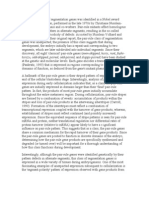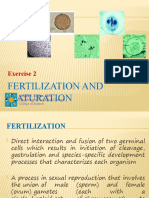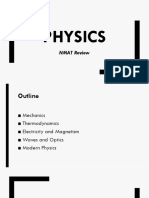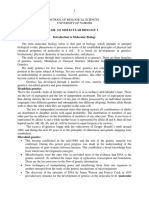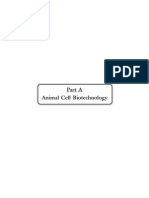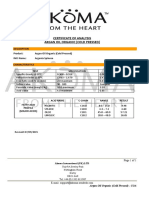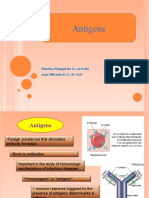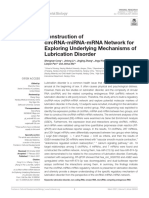Group 6-3ebio: Assoc Prof. Loida R. Medina, PHD, RMT, Rmicro
Group 6-3ebio: Assoc Prof. Loida R. Medina, PHD, RMT, Rmicro
Uploaded by
Anne Olfato ParojinogCopyright:
Available Formats
Group 6-3ebio: Assoc Prof. Loida R. Medina, PHD, RMT, Rmicro
Group 6-3ebio: Assoc Prof. Loida R. Medina, PHD, RMT, Rmicro
Uploaded by
Anne Olfato ParojinogOriginal Title
Copyright
Available Formats
Share this document
Did you find this document useful?
Is this content inappropriate?
Copyright:
Available Formats
Group 6-3ebio: Assoc Prof. Loida R. Medina, PHD, RMT, Rmicro
Group 6-3ebio: Assoc Prof. Loida R. Medina, PHD, RMT, Rmicro
Uploaded by
Anne Olfato ParojinogCopyright:
Available Formats
ACTIVITY 1: INTRODUCTION TO THE CELL: CELLULAR STRUCTURE AND FUNCTION
GROUP 6- 3EBIO Assoc Prof. Loida R. Medina, PhD, RMT, RMicro
Miro, Raphael Christian S. BIO4212
Natividad, Ritchel Mae D. August 30, 2020
Noel, Reanna Rosary R.
Parojinog, Anne O.
ACTIVITY 1
Introduction to the Cell: Cellular Structure and function
1. What is the most conserved genome segment?
Upon searching for sequence similarities in the complete genomes of 13 organisms representing
disparate branches of the evolutionary tree of life, with the use of genome filtering method and MAVID
website, Isenbarger and his colleagues (2008) found that the ribosomal genes, namely the 16S and 23S
ribosomal RNA genes scored as the most highly conserved sequences (at highest scoring non- ribosomal
genetic regions scoring only 37 bits).The sequences identified within the 16S and 23S genes are known to
mediate several important interactions with transfer RNAs in the ribosome A, P, and E sites: with
elongation factors involved in translation; and between regions of the 30S and 50S subunits (Green and
Noller 1997; Yusupov et al. 2001).
2. What is the function of the proteins coded by these genes?
About 30 to 40 percent of these RNA segments are protein (Campbell, 2018). These compounds
bind to tRNAS as well as to other accessory molecules for protein synthesis, move along mRNA and
serve as catalysts in the assembly of amino acids (Lodish et al., 2000). The proteins that are coded by the
23s rRNA and 16s rRNA are associated with the L1 protein binding which primarily allows the L1
protein to be attached or in contact with the cytoskeleton of the cell (Bralant, 1981). The ribosomal
proteins are known for playing an essential role in ribosome assembly and protein translation as well as in
providing the structural framework for the 23S rRNA that actually carries out the peptidyltransferase
reaction (Bhagavan & Ha, 2015).
It is also found that these groups of proteins activate the tumor suppressor p53 pathway in
response to ribosomal stress. In addition, these ribosomal proteins are involved in various physiological
and pathological processes (Zhou et al., 2015). These proteins are generally located on the surface and
fill in the gaps and crevices of the folded RNA, and some contain globular domains on the ribosome
surface that send out extended regions of polypeptide chain that penetrate short distances into holes in the
RNA core. The main role of the ribosomal proteins seems to be to stabilize the RNA core, while
permitting the changes in rRNA conformation that are necessary for this RNA to catalyze efficient protein
synthesis (Alberts et al., 2002). In prokaryotes, the process of translation initiation is primarily promoted
by initiation proteins IF1, IF2, and IF3, which mediate base pairing of the initiator tRNA anticodon to the
mRNA initiation codon located in the ribosomal P-site. According to Jackson et al., (2010), eukaryotes
also have proteins that function in translation initiation, these organisms utilize proteins such as elF1,
elF2, elF3, elF4, and elF5.
3. Give examples of orthologs and paralogs.
ACTIVITY 1: INTRODUCTION TO THE CELL: CELLULAR STRUCTURE AND FUNCTION
In the human retina, according to Li (2006), the genes that codes the middle (OPN1MW gene)
and long-wave (OPN1LW gene) pigments, which are sensitive to green and red colors or the visible
wavelengths of these colors respectively, were first derived from duplication predating the existence of
humans. Despite the two being beside each other in the genome, these regions eventually diverged from
one another. Later, a divergence of the Old World (OW) monkey and human lineages took place yet the
OPN1MW and OPN1LW genes retained their function. As a result, it can be said that the OPN1MW and
BIO4212: ACTIVITY 01 MIRO, NATIVIDAD, NOEL, PAROJINOG:
3EBIO OPN1LW genes of humans are paralogous with one another while the human and OW monkey
OPN1MW gene, as well as the human and OW monkey OPN1LW genes are orthologous.
4. What are the causes of gene speciation and duplication?
As time passes by, Scientists discovered many mechanisms for the evolution of a new gene, one
of which is Duplication event in which it happens naturally all the time, it may be small, nucleotides long
or even an entire gene can be duplicated. From these duplicated genes, further mutations happen with
either a removal of nonfunctional genes or amplification of pre-existing genes.
Three examples of which are the gene duplication of FGF4 in a Dachshund DNA which gives this
dog species powerful legs for digging. This new DNA interacts with their growing bones, reshaping it and
gives rise to several new breeds. Another example is the diet of a Leaf-Eating Monkey which they
achieved by several factors and one of which is gene duplication of RNase1 found in blood, and in the
intestine; a protein once functioned with two separate jobs, was now duplicated to produce proteins with
different jobs. Lastly is the production of factor X (found also freely in blood) which functions to seal
wounds by initiating a series of chemical reactions resulting in a blood clot. Meanwhile the salivary
glands of venomous snake species are abundant with factor X proteins which when they inject into a prey,
will cause a rapid blood clot into the wound. The previous gene used for healing is now a deadly gene.
These examples of rapid mutation in specific parts of genes can ultimately lead to speciation.
5. Is gene speciation and duplication good or bad?
Gene speciation and duplication can either be beneficial or detrimental to the organism, or in the
same way it is to its environment and other organisms. Personally, I think it is neutral because, the
mutations happening in an organism for example an evolved prey to escape its predators, and to avoid
hunger, predators also adapt and evolve to the ways of its prey by different factors, and the cycle will go
on and on. Also it applies to the present times, as when viruses were discovered, humans made vaccines
to prevent the spread of viruses, and subsequently viruses also evolved to a more virulent type to avoid
the resistance given by the vaccines, and other drugs. So we cannot simply label gene speciation and
duplication as good or bad, but we can think of it as a natural thing to occur in this world.
6. What is the endosymbiotic theory?
Endosymbiotic theory is one of the proposed theories explaining the prokaryotic origin of the
eukaryotic cell, an idea rekindled by Lynn Margulis. Accordingly, a cell consumed another cell and let it
reproduce inside, giving an outcome of co-existence. The endosymbiosis involved at least an anaerobic
prokaryote host and an aerobic prokaryotic microbe which is the one being ingested. As the ingested cells
adapt inside its host cell, the mitochondria and chloroplasts are formed eventually (Gray, 2017 and Martin
et.al., 2015).
ACTIVITY 1: INTRODUCTION TO THE CELL: CELLULAR STRUCTURE AND FUNCTION
7. What are the evidence that eukaryotic cells evolved from bacterial cells?
It is to consider that there are more than one cell inside the host cell. Examples of endosymbiotic
relationships are amoeba and ciliates with their endosymbionts. As the endosymbiosis tooks place, the
evolutionary development of the mitochondrion came after. Cells possessing mitochondria can attain cell
BIO4212: ACTIVITY 01 MIRO, NATIVIDAD, NOEL, PAROJINOG:
3EBIO complexity using bioenergetic means (Journey to the Microcosmos, 2019 and Martin et.al., 2015).
Meanwhile, the photosynthetic prokaryotes, being able to produce their own DNA with their
chloroplasts, were said to have undergone independent symbiosis such as the Paramecium bursaria.
Through the course of time, the symbionts were inherited by the next generation and mutualism occurred
between them. (Journey to the Microcosmos, 2019; Martin et.al., 2015; and Gray, 2017).
References:
Journal Articles
Alberts B, Johnson A, Lewis J, et al. Molecular Biology of the Cell. 4th edition. New York:
Garland Science; 2002. From RNA to Protein. Available from:
https://www.ncbi.nlm.nih.gov/books/NBK26829/
Bhagavan, N., & Ha, C. (2015). RNA and Protein Synthesis. Essentials of Medical Biochemistry, 419-
446. doi:10.1016/b978-0-12-416687-5.00023-3
Branlant, C., Krol, A., Machatt, M. A., Pouyet, J., Ebel, J., Edwards, K., & Kössel, H. (1981).
Primary and secondary structures of Escherichia coli MRE 600 23S ribosomal RNA.
Comparison with models of secondary structure for maize chloroplast 23S rRNA and for large
portions of mouse and human 16S mitochondrial rRNAs. Nucleic Acids Research, 9(17), 4303-
4324. doi:10.1093/nar/9.17.4303
Gray, M.W. (2017). Lynn Margulis and the endosymbiont hypothesis: 50 years later. Molecular Biology
of the Cell 28:1285-1287. DOI:10.1091/mbc.E16-07-0509
Green R, Noller HF (1997) Ribosomes and translation. Annu Rev Biochem 66:679–716.
10.1146/annurev.biochem.66.1.679
Isenbarger, T. A., Carr, C. E., Johnson, S. S., Finney, M., Church, G. M., Gilbert, W., Ruvkun, G. (2008).
The Most Conserved Genome Segments for Life Detection on Earth and Other Planets. Origins
of Life and Evolution of Biospheres, 38(6), 517-533. doi:10.1007/s11084-008-9148-z
Jackson, R., Hellen, C., Pestova, T. The mechanism of eukaryotic translation initiation and
principles of its regulation. Nat Rev Mol Cell Biol. 2010;11(2):113-127.
doi:10.1038/nrm2838
Li, W.-H. (2006). Homologous, Orthologous and Paralogous Genes. Encyclopedia of Life Sciences.
doi:10.1038/npg.els.0005297
Lodish, H., Berk, A., Zipursky, S. (2010).. Molecular Cell Biology. 4th edition. New York: W. H.
Freeman . Section 4.4, The Three Roles of RNA in Protein Synthesis.
BIO4212: ACTIVITY 01 MIRO, NATIVIDAD, NOEL, PAROJINOG:
3EBIO
Available from: https://www.ncbi.nlm.nih.gov/books/NBK21603/
Martin, W.F., Garg, S. & Zimorski, V. (2015). Endosymbiotic theories for Eukaryote origin.
Philosophical Transactions of the Royal Society B 370(1678): 20140330.
doi:10.1098/rstb.2014.0330.
Yusupov MM, Yusupova GZ, Baucom A, et al. Crystal structure of the ribosome at 5.5 A
resolution. Science. 2001;292(5518):883-896. doi:10.1126/science.1060089
Zhou, X., Liao, W., Liao, J., Liao, P., & Lu, H. (2015). Ribosomal proteins: Functions beyond the
ribosome. Journal of Molecular Cell Biology, 7(2), 92-104. doi:10.1093/jmcb/mjv014
Video
Journey to the Microcosmos (2019, July 23). Where did Eukaryote came from?- A Journey into
Endosymbiotic Theory. Youtube. https://www.youtube.com/watch?v=4LhBZ2H5SwM
BIO4212: ACTIVITY 01 MIRO, NATIVIDAD, NOEL, PAROJINOG:
3EBIO
You might also like
- Atlas Patrones ANADocument56 pagesAtlas Patrones ANAkemitaNo ratings yet
- 5 - Experiment 1 - Cell Water Potential PDFDocument7 pages5 - Experiment 1 - Cell Water Potential PDFPaula Kaye HerreraNo ratings yet
- Lab Report 3 ProteinDocument6 pagesLab Report 3 Proteinapi-384857069100% (1)
- Cells and Organelles New - Answer KEY - FinalDocument9 pagesCells and Organelles New - Answer KEY - FinalMelyza Ann Pronebo50% (2)
- MCQ Nucleic AcidsDocument4 pagesMCQ Nucleic AcidsAbiramee Ramalingam33% (3)
- Experiment 2: Kinematics of Human MotionDocument5 pagesExperiment 2: Kinematics of Human MotionKat DinoNo ratings yet
- The PairDocument3 pagesThe PairYogesh VyasNo ratings yet
- Experiment # 2: Kinematics of Human MotionDocument7 pagesExperiment # 2: Kinematics of Human MotionToni Andrei CervalesNo ratings yet
- Expt 5. CMB LabDocument11 pagesExpt 5. CMB Labememlamento1No ratings yet
- English 2Document2 pagesEnglish 2Earn8348No ratings yet
- Materials and Methods A. Determination of Water PotentialDocument4 pagesMaterials and Methods A. Determination of Water PotentialIvy CruzNo ratings yet
- Oral Report Experiment 2 DraftDocument20 pagesOral Report Experiment 2 DraftChristine Danica BiteraNo ratings yet
- Fertilization and Maturation: Exercise 2Document19 pagesFertilization and Maturation: Exercise 2Abi Garcia100% (1)
- Ex 2 CmblabDocument31 pagesEx 2 CmblabrexartoozNo ratings yet
- CMB Lab 1 9 1Document19 pagesCMB Lab 1 9 1rexartooz100% (1)
- Physio Formal ReportDocument9 pagesPhysio Formal ReportKat BuenaflorNo ratings yet
- 10 Tips To Improve Your Pipetting TechniqueDocument1 page10 Tips To Improve Your Pipetting TechniqueMihai IonitaNo ratings yet
- MSA BiologyDocument7 pagesMSA BiologyJohn Green100% (2)
- A Reflection On: Existence Precedes EssenceDocument1 pageA Reflection On: Existence Precedes EssenceJadess FusioNo ratings yet
- CMB Lab Oral ReportDocument17 pagesCMB Lab Oral ReportKai ChenNo ratings yet
- Bio Cheat SheetDocument2 pagesBio Cheat Sheetboardermikie69100% (1)
- Drosophila Dihybrid Cross Lab Genetics f13Document6 pagesDrosophila Dihybrid Cross Lab Genetics f13api-2497729890% (1)
- NematodaDocument96 pagesNematodaPurplesmilezNo ratings yet
- 01 Mind-Body SummaryDocument5 pages01 Mind-Body SummaryAbdulrahim Sheikh TrabNo ratings yet
- Staining in Histopathologic TechniquesDocument3 pagesStaining in Histopathologic TechniquesJay Castillo50% (2)
- Ringer's Solution Stimulates The Blood Plasma of Frogs and Moistens The Exposed Muscle. Isotonic To Amphibians - Hypertonic To HumansDocument2 pagesRinger's Solution Stimulates The Blood Plasma of Frogs and Moistens The Exposed Muscle. Isotonic To Amphibians - Hypertonic To Humansmaypeee100% (1)
- NMAT Review - PhysicsDocument76 pagesNMAT Review - PhysicsHyacinthjade SantosNo ratings yet
- Biology Nmat @Document6 pagesBiology Nmat @Ma. Ellah Patricia M. GutierrezNo ratings yet
- The Three Parts of The SoulDocument4 pagesThe Three Parts of The SoulJon David RodriguezNo ratings yet
- Experiment 1Document10 pagesExperiment 1Alyssa Gail de Vera100% (1)
- The Cell QuizDocument7 pagesThe Cell QuizChris GayleNo ratings yet
- Movie Review: The PhilosophersDocument2 pagesMovie Review: The PhilosophersRed dyNo ratings yet
- Philosophy of Science Handout - The Problem of InductionDocument3 pagesPhilosophy of Science Handout - The Problem of InductionKinez72No ratings yet
- ExistensialismDocument4 pagesExistensialismCecile Yul BulanteNo ratings yet
- Critique On Thomas Nagel'sDocument10 pagesCritique On Thomas Nagel'sMandip Jung SibakotiNo ratings yet
- GEN BIO (2nd QT)Document11 pagesGEN BIO (2nd QT)joyNo ratings yet
- Darwin's Theory of EvolutionDocument8 pagesDarwin's Theory of EvolutionRazelle Olendo100% (1)
- Introduction To Parasitology LaboratoryDocument18 pagesIntroduction To Parasitology LaboratoryCrisiant DolinaNo ratings yet
- Gen Physics Activity 1 Formal ReportDocument7 pagesGen Physics Activity 1 Formal ReportAldrin AgawinNo ratings yet
- Discovery of DNA Structure and Function Watson and CrickDocument8 pagesDiscovery of DNA Structure and Function Watson and CrickAndrés PáezNo ratings yet
- CMB Lab Written Report Ex 4Document5 pagesCMB Lab Written Report Ex 4Fiona SimeonNo ratings yet
- Systematic Knowledge Applied Science Example Solar Panels Solar-Powered LightsDocument5 pagesSystematic Knowledge Applied Science Example Solar Panels Solar-Powered LightsAngelo AlejandroNo ratings yet
- Experiment 2 FORMAL REPORTDocument6 pagesExperiment 2 FORMAL REPORTChristine Danica BiteraNo ratings yet
- SynopsisDocument3 pagesSynopsisblueberry.456.blueNo ratings yet
- Brazilian Wasp Venom Kills Cancer Cells by Opening Them UpDocument10 pagesBrazilian Wasp Venom Kills Cancer Cells by Opening Them UpAlf. Andres I. KarrnakisNo ratings yet
- Generic Master ChefsDocument11 pagesGeneric Master ChefsAquib AmirNo ratings yet
- Chapter 1-6 AnswersDocument11 pagesChapter 1-6 AnswersJeevikaGoyalNo ratings yet
- What Is BioinformaticsDocument21 pagesWhat Is BioinformaticsronojoysenguptaNo ratings yet
- Much of what is known about prokaryoticDocument9 pagesMuch of what is known about prokaryotickinnerakakarla970No ratings yet
- 4 1-4 2Document5 pages4 1-4 2owmnerdzNo ratings yet
- Concept of GeneDocument12 pagesConcept of GeneDavid trumpNo ratings yet
- January 2011 INS - Unit 5 Edexcel Biology A-LevelDocument10 pagesJanuary 2011 INS - Unit 5 Edexcel Biology A-LevelheyitsmemuahNo ratings yet
- Compannot 101616Document8 pagesCompannot 101616api-320970548No ratings yet
- Genetics 1.1 ResumeDocument102 pagesGenetics 1.1 ResumemiertschinkNo ratings yet
- Protein Fish LabAnswersDocument14 pagesProtein Fish LabAnswersrahmi93No ratings yet
- The Gene Ontology Consortium - Gene Ontology: Tool For The Unification of BiologyDocument5 pagesThe Gene Ontology Consortium - Gene Ontology: Tool For The Unification of BiologyYopghm698No ratings yet
- Compilation of Output in Genetics (Midterm) : Romblon State University Cajidiocan Campus Cajidiocan RomblonDocument21 pagesCompilation of Output in Genetics (Midterm) : Romblon State University Cajidiocan Campus Cajidiocan RomblonJudy RianoNo ratings yet
- Seminar - Viruses, Prions and Viroids-Infectious AgentsDocument36 pagesSeminar - Viruses, Prions and Viroids-Infectious AgentsAgbede Oluwadamilare BenjaminNo ratings yet
- Extraction and Isolation of Genetic Material From Cheek CellsDocument8 pagesExtraction and Isolation of Genetic Material From Cheek CellsFiel Cris LansangNo ratings yet
- NIH Public Access: Author ManuscriptDocument9 pagesNIH Public Access: Author ManuscriptAndressa AlvesNo ratings yet
- Synopsis Biology AEODocument4 pagesSynopsis Biology AEOnoyNo ratings yet
- Unit 3 (1) ..Document4 pagesUnit 3 (1) ..Valentina RamírezNo ratings yet
- L1 IntroductionDocument3 pagesL1 IntroductionSandra MwendeNo ratings yet
- Fundamentals of Microbiome Science: How Microbes Shape Animal BiologyFrom EverandFundamentals of Microbiome Science: How Microbes Shape Animal BiologyRating: 3 out of 5 stars3/5 (2)
- Template of Semilog PDFDocument1 pageTemplate of Semilog PDFAnne Olfato ParojinogNo ratings yet
- STS Asynchronous 1Document1 pageSTS Asynchronous 1Anne Olfato ParojinogNo ratings yet
- Outline - Chapter 16Document2 pagesOutline - Chapter 16Anne Olfato ParojinogNo ratings yet
- Marrero-Acop Pediatric Clinic & HospitalDocument1 pageMarrero-Acop Pediatric Clinic & HospitalAnne Olfato ParojinogNo ratings yet
- Scientist University of Santo Tomas: Nikki Heherson DagamacDocument1 pageScientist University of Santo Tomas: Nikki Heherson DagamacAnne Olfato ParojinogNo ratings yet
- Total Number of Participants: Total Number of Respondents:: CriteriaDocument4 pagesTotal Number of Participants: Total Number of Respondents:: CriteriaAnne Olfato ParojinogNo ratings yet
- Conservation of Mass: Key PointsDocument3 pagesConservation of Mass: Key PointsAnne Olfato ParojinogNo ratings yet
- AbstractDocument1 pageAbstractAnne Olfato ParojinogNo ratings yet
- Liworiz - Life and Works of Rizal Lesson 1 Synchronous Class NotesDocument2 pagesLiworiz - Life and Works of Rizal Lesson 1 Synchronous Class NotesAnne Olfato ParojinogNo ratings yet
- Differences Between Kick Sampling Techniques and Short-Term Hester-Dendy Sampling For Stream MacroinvertebratesDocument10 pagesDifferences Between Kick Sampling Techniques and Short-Term Hester-Dendy Sampling For Stream MacroinvertebratesAnne Olfato ParojinogNo ratings yet
- Monthly Average Surface Water Temperature From 2001 - 2011Document3 pagesMonthly Average Surface Water Temperature From 2001 - 2011Anne Olfato ParojinogNo ratings yet
- 2015 Aug 18 - Herried - Designing Maps For Scientific PublicationDocument63 pages2015 Aug 18 - Herried - Designing Maps For Scientific PublicationAnne Olfato ParojinogNo ratings yet
- Permission To Post (PTP) FormDocument1 pagePermission To Post (PTP) FormAnne Olfato ParojinogNo ratings yet
- The Surgeon With HBV, HCV, or Hiv: ObjectivesDocument8 pagesThe Surgeon With HBV, HCV, or Hiv: ObjectivesAnne Olfato ParojinogNo ratings yet
- Biostat Finals ReviewerDocument4 pagesBiostat Finals ReviewerAnne Olfato ParojinogNo ratings yet
- Combinepdf 7Document129 pagesCombinepdf 7Joe JosephNo ratings yet
- Module 3 Quiz 1 - MICRO 22Document4 pagesModule 3 Quiz 1 - MICRO 22Julio CastilloNo ratings yet
- Solid Lipid Nanoparticles For Drug Delivery: Pharmacological and Biopharmaceutical AspectsDocument24 pagesSolid Lipid Nanoparticles For Drug Delivery: Pharmacological and Biopharmaceutical AspectsGabrielNo ratings yet
- Animal Cell Culture-MediaDocument10 pagesAnimal Cell Culture-MediadivakaratoceNo ratings yet
- Campbell BookreviewDocument4 pagesCampbell Bookreviewlaura babjakovaNo ratings yet
- Binary and Shuttle VectorDocument9 pagesBinary and Shuttle Vectordank memer100% (1)
- IAL - Biology - SB2 - Mark Scheme - 8BDocument3 pagesIAL - Biology - SB2 - Mark Scheme - 8BsalmaNo ratings yet
- BIO1A03 Post-Lab 4 AssignmentDocument5 pagesBIO1A03 Post-Lab 4 Assignmentbronwynmac3No ratings yet
- De La Salle Lipa - Integrated School - Senior High School - Science Learning Area - GENERAL BIOLOGY 2Document8 pagesDe La Salle Lipa - Integrated School - Senior High School - Science Learning Area - GENERAL BIOLOGY 2LANCE FREDERICK DIMAANONo ratings yet
- Argan Oil Reported Benefits.Document1 pageArgan Oil Reported Benefits.Dhaval SoniNo ratings yet
- Antigens: Martha Margarita G. Arevalo Ana Mikaela D.O. de AsisDocument44 pagesAntigens: Martha Margarita G. Arevalo Ana Mikaela D.O. de AsisCherry Reyes-PrincipeNo ratings yet
- Samian AQA Biology GCSE Combined B1 Practice AnswersDocument2 pagesSamian AQA Biology GCSE Combined B1 Practice AnswersMahebul MazidNo ratings yet
- Experiment 8 - Qualitative Tests For CarbohydratesDocument5 pagesExperiment 8 - Qualitative Tests For CarbohydratesJuren LasagaNo ratings yet
- Bio 201 Laboratory ReportDocument5 pagesBio 201 Laboratory Reportapi-252855115No ratings yet
- In Ammation and Atherosclerosis: Signaling Pathways and Therapeutic InterventionDocument24 pagesIn Ammation and Atherosclerosis: Signaling Pathways and Therapeutic InterventionZahroNo ratings yet
- IBO 2004 Theory Part 2Document62 pagesIBO 2004 Theory Part 2pdbiocompNo ratings yet
- 全转录-Construction of circRNA-miRNA-mRNA Network for Exploring Underlying Mechanisms of Lubrication DisorderDocument11 pages全转录-Construction of circRNA-miRNA-mRNA Network for Exploring Underlying Mechanisms of Lubrication Disorder张议No ratings yet
- 2 Cladograms - BioNinjaDocument5 pages2 Cladograms - BioNinjaRosie SunNo ratings yet
- STD 10th Perfect Science and Technology 2 Notes English Medium MH BoardDocument24 pagesSTD 10th Perfect Science and Technology 2 Notes English Medium MH BoardSatyam Patil67% (3)
- Fourier Transform InfraredDocument29 pagesFourier Transform InfraredrinjaniNo ratings yet
- Work and Energy in Muscles: Why Can't I Sprint Forever?Document30 pagesWork and Energy in Muscles: Why Can't I Sprint Forever?Martín BiancalanaNo ratings yet
- Prix C 111Document2 pagesPrix C 111Mezouar AbdennacerNo ratings yet
- ENVS 532: DR Assad Al-Thukair Associate ProfessorDocument16 pagesENVS 532: DR Assad Al-Thukair Associate ProfessorAbu Muhsin Al NgapakyNo ratings yet
- Cytoplasm Animal Cell FunctionDocument3 pagesCytoplasm Animal Cell Functionhaydunn55No ratings yet
- Katzung, B Farmakologi Dasar Dan Klinik Edisi 10. Jakarta - EGC, 2010.Document5 pagesKatzung, B Farmakologi Dasar Dan Klinik Edisi 10. Jakarta - EGC, 2010.M. Yusuf DaliNo ratings yet
- Gel Electrophoresis Lab Report Stephen Price July 8, 2018 BiologyDocument5 pagesGel Electrophoresis Lab Report Stephen Price July 8, 2018 BiologyMo IlBahraniNo ratings yet






